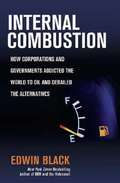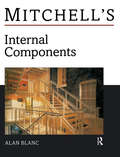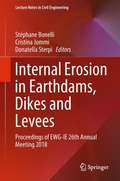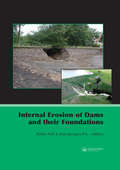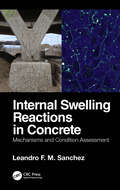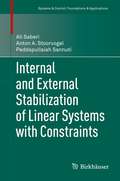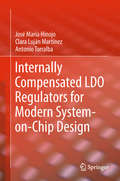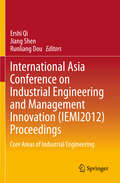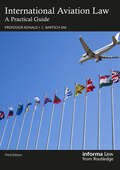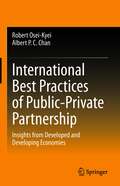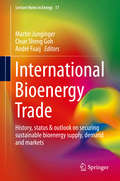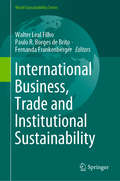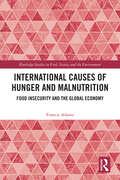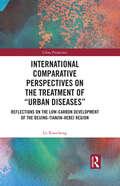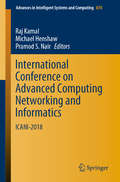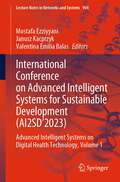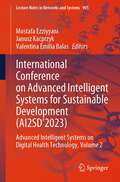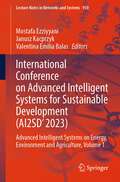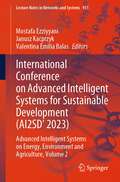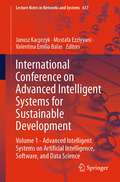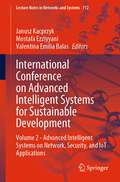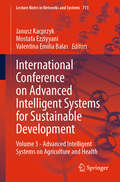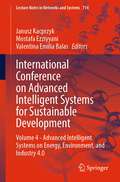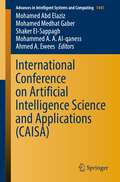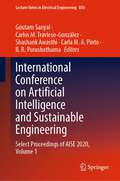- Table View
- List View
Internal Combustion: How Corporations and Governments Addicted the World to Oil and Derailed the Alternatives
by Edwin BlackThis book describes the history of corruption and manipulation that has subjected the U.S. and the world to the petroleum industry and private car usage.
Internal Components (Mitchell's Building Series)
by Alan BlancThis book and its companion volume External Components encourage an evaluation of alternative methods for putting components together. Both use contemporary case studies to relate component design to real building.
Internal Erosion in Earthdams, Dikes and Levees: Proceedings Of Ewg-ie 26th Annual Meeting 2018 (Lecture Notes in Civil Engineering #17)
by Stéphane Bonelli Cristina Jommi Donatella SterpiThis book gathers the peer-reviewed contributions presented at the 26th Annual Meeting of the European Working Group on Internal Erosion in Embankment Dams, Levees and Dikes, and their Foundations (EWG-IE), held in Milano, Italy, on 10-13 September 2018. The meeting served as a fertile platform for discussion, sharing sound knowledge and introducing novel ideas on issues related to soil internal erosion in water retaining structures. The contributions encompass various aspects of laboratory techniques and findings, modelling and design criteria as well as prevention measures and field assessment. The book is a valuable, up-to-date tool that provides an essential overview of the subject for scientists and practitioners alike, and inspires further investigations and research.
Internal Erosion of Dams and Their Foundations: Selected and Reviewed Papers from the Workshop on Internal Erosion and Piping of Dams and their Foundations, Aussois, France, 25-27 April 2005
by Jean-Jacques Fry Robin FellInternal erosion and piping in embankments and their foundations is the main cause of failures and accidents to embankment dams. For new dams, the potential for internal erosion and piping can be controlled by good design and construction of the core of the dam and provision of filters to intercept seepage through the embankment and the foundations
Internal Swelling Reactions in Concrete: Mechanisms and Condition Assessment
by Leandro F. SanchezAs critical concrete infrastructure deteriorates, engineers need efficient and reliable techniques to appraise the causes and the extent of deterioration, to evaluate the structural consequences and to select effective management protocols and rehabilitation strategies. This book looks at deterioration caused by internal swelling reaction (ISR) mechanisms in concrete, such as alkali-aggregate reaction, delayed ettringite formation and freeze-thaw cycles.The book provides accessible and comprehensive coverage of recent work and developments on the most common ISR mechanisms leading to induced expansion and deterioration. It addresses the implications of ISR on different scales (micro, meso and macro), outlines qualitative and quantitative techniques to assess the condition of affected concrete and introduces the multi-level assessment protocol, using advanced microscopic and mechanical techniques, particularly the stiffness damage test and damage rating index, as a reliable approach to appraise ISR-affected infrastructure. Also included is a detailed case study of the Robert-Bourassa Charest Overpass in Quebec.Internal Swelling Reactions in Concrete: Mechanisms and Condition Assessment is primarily intended for undergraduate and graduate students, as well as academics interested in the field of concrete durability and condition assessment of concrete. It will also be of interest to engineers and infrastructure owners dealing with ISR-related problems.
Internal and External Stabilization of Linear Systems with Constraints
by Peddapullaiah Sannuti Ali Saberi Anton A. StoorvogelUnifying two decades of research, this book is the first to establish a comprehensive foundation for a systematic analysis and design of linear systems with general state and input constraints. For such systems, which can be used as models for most nonlinear systems, the issues of stability, controller design, additonal constraints, and satisfactory performance are addressed. The book is an excellent reference for practicing engineers, graduate students, and researchers in control systems theory and design. It may also serve as an advanced graduate text for a course or a seminar in nonlinear control systems theory and design in applied mathematics or engineering departments. Minimal prerequisites include a first graduate course in state-space methods as well as a first course in control systems design.
Internally Compensated LDO Regulators for Modern System-on-Chip Design
by José María Hinojo Clara Luján Martínez Antonio TorralbaThis book presents a thorough state-of-the-art review for internally compensated Low Dropout Regulators (IC-LDO). It serves as a useful guide for circuit designers. The advantages and disadvantages of each cell proposed are highlighted. The authors describe an alternative to the classical topology; the Flipped Voltage Follower (FVF), which has been recently applied in the design of internally compensated LDOs to enhance their performances. This book provides novel circuits enhancing those parameters of LDO related with frequency behavior and power consumption. These solutions, as well as their appropriate design methodology, are properly described within the text.
International Asia Conference on Industrial Engineering and Management Innovation (IEMI2012) Proceedings: Core Areas of Industrial Engineering
by Ershi Qi Jiang Shen Runliang DouThe International Conference on Industrial Engineering and Engineering Management is sponsored by the Chinese Industrial Engineering Institution, CMES, which is the only national-level academic society for Industrial Engineering. The conference is held annually as the major event in this arena. Being the largest and the most authoritative international academic conference held in China, it provides an academic platform for experts and entrepreneurs in the areas of international industrial engineering and management to exchange their research findings. Many experts in various fields from China and around the world gather together at the conference to review, exchange, summarize and promote their achievements in the fields of industrial engineering and engineering management. For example, some experts pay special attention to the current state of the application of related techniques in China as well as their future prospects, such as green product design, quality control and management, supply chain and logistics management to address the need for, amongst other things low-carbon, energy-saving and emission-reduction. They also offer opinions on the outlook for the development of related techniques. The proceedings offers impressive methods and concrete applications for experts from colleges and universities, research institutions and enterprises who are engaged in theoretical research into industrial engineering and engineering management and its applications. As all the papers are of great value from both an academic and a practical point of view, they also provide research data for international scholars who are investigating Chinese style enterprises and engineering management.
International Aviation Law: A Practical Guide
by Ronald I. Bartsch AMThis is the third edition of a now-renowned guide that provides an extensive account of the state of the aviation industry and the law that regulates it. This new edition, revised and updated throughout, focuses on environmental and sustainability considerations, and includes a new chapter on innovations aimed towards meeting the 2050 Net Zero Emission targets endorsed by the International Civil Aviation Organisation (ICAO) and the International Air Transport Association (IATA).International Aviation Law: A Practical Guide explains the international context and application of the law as it applies to commercial and recreational aviation, and to the broader aviation environment. It provides a comprehensive introduction to all aspects of aviation law, from criminal law to contract law, to the legal duties and responsibility of aircrew and other aviation personnel including airport operators, air traffic controllers and aircraft engineers. Each area of the law is clearly explained in accessible language and supported with practical case studies to illustrate the application of the law within an operational aviation context. It also provides advice on how to avoid or minimize legal liability for those working in the aviation industry.The book is written for a very broad readership of those working within the aviation industry, those aspiring to work within it and those within the legal profession dealing with air transportation, as well as students within the same industries. The third edition will additionally find favour with new readers seeking information on environmental issues and answers to the question of how the aviation sector will meet the 2050 emission targets.
International Best Practices of Public-Private Partnership: Insights from Developed and Developing Economies
by Albert P. Chan Robert Osei-KyeiThis book discusses how Public-Private Partnership (PPP) is practiced in developed and developing economies. The book demonstrates how PPP as a concept has grown over the years with many governments particularly from developing economies/countries seeking to enhance infrastructure growth and development through this scheme. Further, the book explores how PPP has become the major infrastructure procurement policy adopted by many governments globally to address the rapid increase in demand for infrastructure due to the increase in population growth. Although, there are many available textbooks on PPP, this book is unique because it provides in-depth analysis and discussion on the international best practices of PPP from developed and developing economies perspectives. This book provides strategic measures, useful practices and information about the similarities and differences in PPP practices in developed and developing economies based on empirical evidence and case studies. This book is structured in nine chapters. The first chapter explores the basic concept of PPPs. The second chapter looks at the global development and practices of PPP particularly from developed and developing economies’ perspectives. The third to the eight chapters explores critical topics and issues in international PPP practices from developed and developing economies perspectives. The topics included in this book are: governments motivations for adopting PPPs, barriers to PPP implementation, measuring PPP project success, risk management in PPPs, causes of conflict and conflict resolution mechanisms in PPPs and management of unsolicited proposals. The ninth chapter presents a comprehensive best practice framework for implementing international PPP projects. This book is useful to undergraduate and postgraduate students in architecture, civil engineering, business, construction and project management, researchers interested in PPP topics, international investors and financiers, public authorities and departments and international development banks. This book provides in-depth insights and understanding on the best practices for PPP from the international perspective especially from the viewpoint of countries with diverse culture and policies. Importantly, readers will be adequately informed of the similarities and differences of PPP practices and processes in developed and developing economies based on empirical evidence. Investors and governments will be informed of the strategic plans and preventive actions to employ when engaging in PPP arrangements in any part of the world.
International Bioenergy Trade
by Martin Junginger Chun Sheng Goh André FaaijThe trade of global bioenergy commodities, such as ethanol, biodiesel and wood pellets has been growing exponentially in the past decade, and have by 2013 reached true "commodity" volumes, i. e. tens of millions of tonnes traded each year, and billions (both in US$/e) of annual turnover. IEA Bioenergy Task 40 was founded in 2004 and is now in its 4th triennium. For the past 9 years, task 40 has monitored the developments in international bioenergy trade, including the organization of about 20 workshops on trade-related topics, and the publication of over 100 studies, country reports, newsletters, etc. The amount of material produced over the years and insights gained in how biomass markets and international trade of biomass and biofuels has developed is impressive. Besides that the group has produced overviews and insights, also a large amount of practical experience has been brought together in what works and what doesn't. Last but not least, based on all this, there are clear(er) views on how to proceed to build working sustainable international biomass markets in the future. This book compiles those lessons and insights into an easily accessible book publication.
International Business, Trade and Institutional Sustainability (World Sustainability Series)
by Walter Leal Filho Fernanda Frankenberger Paulo R. Borges de BritoThis book addresses the gap between innovative technologies and their adoption. It showcases research, feasibility studies and projects that demonstrate a variety of ways to implement environmental sustainability in globally operating firms, as well as best practices in areas such as international management, adoption of cleaner technologies, global supply chains, greenhouse gas emission reduction, and transportation.The book provides state-of-the-art information on issues including:Global sustainable management practicesGlobal sustainable food and agricultural marketsGlobal responsible mining and energyGlobal sustainable sourcingGlobal sustainable transportationGlobal conservation innovations and investmentsPresenting expert contributions from industry, government and academia, discussing a variety of themes and perspectives on the topic "international business as a positive force of environmental sustainability” it is a vital resource for stakeholders in the international business community.
International Causes of Hunger and Malnutrition: Food Insecurity and the Global Economy (Routledge Studies in Food, Society and the Environment)
by Francis AdamsThis book examines the international causes of hunger and malnutrition and reveals how critical elements of the global economy heighten food insecurity in the developing world.At present, over two billion people in the developing world do not have secure access to safe, sufficient, and nutritious food. With the global population projected to rise to almost 10 billion by 2050, ensuring universal access to food will become increasingly urgent. The global community will need to redouble its efforts to effectively address the underlying causes of food insecurity. Within countries, a number of causes – poverty, poor governance, civil conflict, environmental decline - are immediately apparent and must be addressed to have any hope of lessening hunger and malnutrition. At the same time, a number of other factors well beyond national borders often constitute equal or greater obstacles to meeting the nutritional needs of all people. These factors are not nearly as visible and are largely outside the control of individual countries and local communities. This book examines how core elements of the global economy cause, prolong, and intensify food insecurity in the developing world. Emphasis is placed on agricultural trade, seed privatization, transnational land acquisitions, industrial fishing, and climate change. Understanding how these five factors impact the poorest communities in the poorest countries is essential for constructing an equitable, inclusive, and sustainable global food system that meets the nutritional needs of all people. By highlighting five major international causes of hunger and malnutrition, this book offers an alternate framework for understanding and combatting global food insecurity.This book will be of particular interest to students, scholars, and practitioners in the fields of global food security, international development, and global political economy.
International Comparative Perspectives on the Treatment of “Urban Diseases”: Reflections on the Low-Carbon Development of the Beijing-Tianjin-Hebei Region (China Perspectives)
by Lu XiaochengWith an integration of theories, comparative and empirical studies, this book aims to find a treatment for Beijing’s “urban diseases” and coordinate a low-carbon development plan for the Beijing-Tianjin-Hebei region in China. Unprecedented industrialization and unconventional urbanization caused a series of “urban diseases” for developing cities across the globe. By summarizing and exploring the evolution and phased characteristics of “urban diseases”, the author implements theories across classical sociology, human ecology, community school, and low-carbon city as the base for policy recommendations. This book also provides in-depth examinations and comparative studies of other metropolises’ experiences in controlling “urban diseases”. Cities such as New York, London, and Tokyo were modeled to propose the most appropriate low-carbon development plan for the Beijing-Tianjin-Hebei region. With a focus on developing cities in Northern China, this book will be a great read to all scholars and students of environmental studies, development studies, urban studies, and contemporary China studies. It will also be a great addition for those who are interested in social conflicts and economic development.
International Conference on Advanced Computing Networking and Informatics: ICANI-2018 (Advances in Intelligent Systems and Computing #870)
by Raj Kamal Michael Henshaw Pramod S. NairThe book comprises selected papers presented at the International Conference on Advanced Computing, Networking and Informatics (ICANI 2018), organized by Medi-Caps University, India. It includes novel and original research work on advanced computing, networking and informatics, and discusses a wide variety of industrial, engineering and scientific applications of the emerging techniques in the field of computing and networking.
International Conference on Advanced Intelligent Systems for Sustainable Development: Advanced Intelligent Systems on Digital Health Technology, Volume 1 (Lecture Notes in Networks and Systems #904)
by Janusz Kacprzyk Valentina Emilia Balas Mostafa EzziyyaniThis book encapsulates the innovative discussions held during the International Conference on Advanced Intelligent Systems for Sustainable Development (AI2SD'2023), which took place at Mohammed 6 University of Sciences and Health Casablanca, Morocco. This book delves into the multifaceted realm of advanced intelligent systems, specifically focusing on digital health technology. The book offers a comprehensive exploration of cutting-edge research and breakthroughs in this dynamic field, providing a holistic perspective on the latest advancements. Within these pages, you will find papers covering an array of captivating topics, including AI-driven diagnostics, wearable health devices, predictive analytics in health care, and much more. Each contribution delves into the synergy of intelligent systems and digital health, showcasing how these technologies intertwine to shape the future of healthcare. Designed for researchers, practitioners, and enthusiasts alike, this book serves as an invaluable resource for staying updated on the latest trends and developments in the intersection of advanced intelligent systems and digital health technology. Whether you are seeking to broaden your knowledge or seeking practical insights, this book caters to a diverse readership eager to harness the potential of these innovative domains.
International Conference on Advanced Intelligent Systems for Sustainable Development: Advanced Intelligent Systems on Digital Health Technology, Volume 2 (Lecture Notes in Networks and Systems #905)
by Janusz Kacprzyk Valentina Emilia Balas Mostafa EzziyyaniThis book encapsulates the innovative discussions held during the International Conference on Advanced Intelligent Systems for Sustainable Development (AI2SD'2023), which took place at Mohammed 6 University of Sciences and Health Casablanca, Morocco. This book delves into the multifaceted realm of advanced intelligent systems, specifically focusing on digital health technology. The book offers a comprehensive exploration of cutting-edge research and breakthroughs in this dynamic field, providing a holistic perspective on the latest advancements. Within these pages, you will find papers covering an array of captivating topics, including AI-driven diagnostics, wearable health devices, predictive analytics in health care, and much more. Each contribution delves into the synergy of intelligent systems and digital health, showcasing how these technologies intertwine to shape the future of healthcare. Designed for researchers, practitioners, and enthusiasts alike, this book serves as an invaluable resource for staying updated on the latest trends and developments in the intersection of advanced intelligent systems and digital health technology. Whether you are seeking to broaden your knowledge or seeking practical insights, this book caters to a diverse readership eager to harness the potential of these innovative domains.
International Conference on Advanced Intelligent Systems for Sustainable Development: Advanced Intelligent Systems on Energy, Environment and Agriculture, Volume 1 (Lecture Notes in Networks and Systems #930)
by Janusz Kacprzyk Valentina Emilia Balas Mostafa EzziyyaniThis book is a comprehensive compilation of groundbreaking insights stemming from the esteemed International Conference on Advanced Intelligent Systems for Sustainable Development (AI2SD'2023), hosted at Cadi Ayyad University Morocco. Focused on the crucial themes of energy, environment, agriculture, and industry, this book captures the essence of transformative discussions and cutting-edge research that unfolded during the conference. Within these pages, readers are invited to explore the intricate world of intelligent systems, where innovation converges to tackle the key challenges of sustainability. The book immerses its audience in a wealth of knowledge that deeply represents the latest advancements shaping the future landscape. Diverse topics are intricately woven into the fabric of this discourse, covering AI-driven solutions designed for energy optimization, environmental sustainability, precision agriculture, and intelligent industry applications. Each contribution serves as a testament to the collaborative efforts of researchers, practitioners, and experts who gathered to drive innovation at the intersection of intelligent systems and sustainable development. Crafted as an invaluable resource, 'Advancements in Intelligent Systems: AI2SD'2023 Proceedings‘ caters to a diverse readership eager to delve into the forefront of trends and developments emerging from the crossroads of advanced intelligent systems in energy, environment, agriculture, and industry. Whether you're a researcher, practitioner, or enthusiast, unlock the transformative potential inherent in these innovative domains.
International Conference on Advanced Intelligent Systems for Sustainable Development: Advanced Intelligent Systems on Energy, Environment and Agriculture, Volume 2 (Lecture Notes in Networks and Systems #931)
by Janusz Kacprzyk Valentina Emilia Balas Mostafa EzziyyaniThis book is a comprehensive compilation of groundbreaking insights stemming from the esteemed International Conference on Advanced Intelligent Systems for Sustainable Development (AI2SD'2023), hosted at Cadi Ayyad University Morocco. Focused on the crucial themes of energy, environment, agriculture, and industry, this book captures the essence of transformative discussions and cutting-edge research that unfolded during the conference. Within these pages, readers are invited to explore the intricate world of intelligent systems, where innovation converges to tackle the key challenges of sustainability. The book immerses its audience in a wealth of knowledge that deeply represents the latest advancements shaping the future landscape. Diverse topics are intricately woven into the fabric of this discourse, covering AI-driven solutions designed for energy optimization, environmental sustainability, precision agriculture, and intelligent industry applications. Each contribution serves as a testament to the collaborative efforts of researchers, practitioners, and experts who gathered to drive innovation at the intersection of intelligent systems and sustainable development. Crafted as an invaluable resource, 'Advancements in Intelligent Systems: AI2SD'2023 Proceedings‘ caters to a diverse readership eager to delve into the forefront of trends and developments emerging from the crossroads of advanced intelligent systems in energy, environment, agriculture, and industry. Whether you're a researcher, practitioner, or enthusiast, unlock the transformative potential inherent in these innovative domains.
International Conference on Advanced Intelligent Systems for Sustainable Development: Volume 1 - Advanced Intelligent Systems on Artificial Intelligence, Software, and Data Science (Lecture Notes in Networks and Systems #637)
by Janusz Kacprzyk Valentina Emilia Balas Mostafa EzziyyaniThis book describes the potential contributions of emerging technologies in different fields as well as the opportunities and challenges related to the integration of these technologies in the socio-economic sector. In this book, many latest technologies are addressed, particularly in the fields of computer science and engineering. The expected scientific papers covered state-of-the-art technologies, theoretical concepts, standards, product implementation, ongoing research projects, and innovative applications of Sustainable Development. This new technology highlights, the guiding principle of innovation for harnessing frontier technologies and taking full profit from the current technological revolution to reduce gaps that hold back truly inclusive and sustainable development. The fundamental and specific topics are Big Data Analytics, Wireless sensors, IoT, Geospatial technology, Engineering and Mechanization, Modeling Tools, Risk analytics, and preventive systems.
International Conference on Advanced Intelligent Systems for Sustainable Development: Volume 2 - Advanced Intelligent Systems on Network, Security, and IoT Applications (Lecture Notes in Networks and Systems #712)
by Janusz Kacprzyk Valentina Emilia Balas Mostafa EzziyyaniThis book describes the potential contributions of emerging technologies in different fields as well as the opportunities and challenges related to the integration of these technologies in the socio-economic sector. In this book, many latest technologies are addressed, particularly in the fields of computer science and engineering. The expected scientific papers covered state-of-the-art technologies, theoretical concepts, standards, product implementation, ongoing research projects, and innovative applications of Sustainable Development. This new technology highlights, the guiding principle of innovation for harnessing frontier technologies and taking full profit from the current technological revolution to reduce gaps that hold back truly inclusive and sustainable development. The fundamental and specific topics are Big Data Analytics, Wireless sensors, IoT, Geospatial technology, Engineering and Mechanization, Modeling Tools, Risk analytics, and preventive systems.
International Conference on Advanced Intelligent Systems for Sustainable Development: Volume 3 - Advanced Intelligent Systems on Agriculture and Health (Lecture Notes in Networks and Systems #713)
by Janusz Kacprzyk Valentina Emilia Balas Mostafa EzziyyaniThis book describes the potential contributions of emerging technologies in different fields as well as the opportunities and challenges related to the integration of these technologies in the socio-economic sector. In this book, many latest technologies are addressed, particularly in the fields of computer science and engineering. The expected scientific papers covered state-of-the-art technologies, theoretical concepts, standards, product implementation, ongoing research projects, and innovative applications of Sustainable Development. This new technology highlights, the guiding principle of innovation for harnessing frontier technologies and taking full profit from the current technological revolution to reduce gaps that hold back truly inclusive and sustainable development. The fundamental and specific topics are Big Data Analytics, Wireless sensors, IoT, Geospatial technology, Engineering and Mechanization, Modeling Tools, Risk analytics, and preventive systems.
International Conference on Advanced Intelligent Systems for Sustainable Development: Volume 4 - Advanced Intelligent Systems on Energy, Environment, and Industry 4.0 (Lecture Notes in Networks and Systems #714)
by Janusz Kacprzyk Valentina Emilia Balas Mostafa EzziyyaniThis book describes the potential contributions of emerging technologies in different fields as well as the opportunities and challenges related to the integration of these technologies in the socio-economic sector. In this book, many latest technologies are addressed, particularly in the fields of computer science and engineering. The expected scientific papers covered state-of-the-art technologies, theoretical concepts, standards, product implementation, ongoing research projects, and innovative applications of Sustainable Development. This new technology highlights, the guiding principle of innovation for harnessing frontier technologies and taking full profit from the current technological revolution to reduce gaps that hold back truly inclusive and sustainable development. The fundamental and specific topics are Big Data Analytics, Wireless sensors, IoT, Geospatial technology, Engineering and Mechanization, Modeling Tools, Risk analytics, and preventive systems.
International Conference on Artificial Intelligence Science and Applications (Advances in Intelligent Systems and Computing #1441)
by Mohamed Medhat Gaber Mohamed Abd Elaziz Mohammed A. A. Al-qaness Ahmed A. Ewees Shaker El-SappaghThis book collects different artificial intelligence methodologies that applied to solve real-world problems. This book has exciting chapters that employ artificial intelligence and applied to different applications based on integration with meta-heuristic and other techniques. The area of applications is including medical diagnosis, text analysis, cloud computing, and others which will enrich the reader. In this sense, the book provides practical and theory content with novel artificial intelligence techniques. The chapters were compiled using a scientific perspective. Accordingly, the book is primarily intended for undergraduate and postgraduate students of science, engineering, and computational mathematics and is applied in courses on artificial intelligence, optimization techniques, advanced machine learning, among others.
International Conference on Artificial Intelligence and Sustainable Engineering: Select Proceedings of AISE 2020, Volume 1 (Lecture Notes in Electrical Engineering #836)
by Carlos M. Travieso-González Goutam Sanyal Shashank Awasthi Carla M. A. Pinto B. R. PurushothamaThis book comprises select papers from the International Conference on Artificial Intelligence and Sustainable Engineering (AISE 2020). The volume focuses on the recent advancements in artificial intelligence and addresses how it is useful in achieving truly sustainable solutions. The key strands of this book include artificial intelligence in healthcare, IoT for modern life, security and surveillance, big data analytics, machine learning and computing, communication technologies, gesture technology, virtual intelligence, and audio & speech processing. The book addresses sustainability challenges in various computing techniques and opportunities for sustainable engineering based on AI and supporting tools such as engineering design for sustainable development using IoT/AI, smart cities: waste minimization, remanufacturing, reuse and recycling technologies using IoT/AI, industry 4.0, intelligent and smart grid systems, energy conservation using technology, green engineering/technology, robotic process automation (RPA) and water and air quality management. This book can be a valuable resource for academicians, researchers, and professionals working in AI and its applications.
